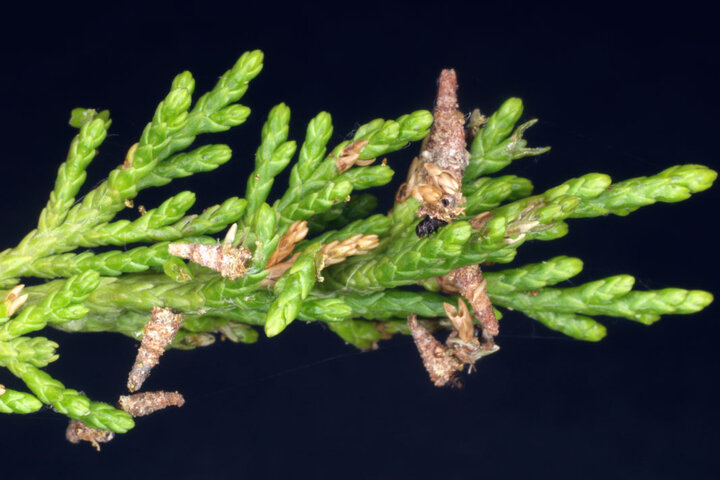Sarah Browning, Nebraska Extension Educator
Mature bagworms fully grown and infesting a juniper. Sarah Browning, Nebraska Extension
If your landscape has a history of bagworm problems, it’s time to start looking for the next generation of young insects. They will soon be hatching.
The insects and their cocoons can be hard for gardeners to spot since they look so much like a natural part of the plant. Many people don’t realize the pointed oval structures the insects create and carry around with them aren’t a natural part of the tree. Last year’s bags are easier to spot than the tiny structures made by new insects.
Bagworms are native to the United States and common in eastern Nebraska. They feed on many species of trees and shrubs, but are most damaging on evergreen trees and shrubs since these plants can't replace the foliage eaten by insects. Juniper, arborvitae, fir, pine, and spruce branches may be killed if completely defoliated. Entire plants can be killed if an infestation goes uncontrolled for several years, although usually bagworm infestations build up slowly over two or three years.
Bagworms also feed on shade, orchard, and forest trees of nearly every kind, as well as many ornamental shrubs and perennials, however severe attacks are unusual. Since deciduous plants regrow new leaves each year, the defoliation caused by bagworm feeding is not a serious problem for these plants. However, the growth of small or newly planted trees could be slowed by heavy leaf feeding.
Bagworm Identification and Lifecycle
After overwintering as eggs inside their mother's bag, a new generation of insects begins hatching in late May and early June. The exact hatching period is determined by temperature, so spring's cooler temperatures may delay their emergence this year. According to the National Phenology Network: Bagworm Forecast, emergence in southeastern Nebraska is occurring now, while emergence in northeastern parts of the state are expected in the next week.

The adult male bagworm is a small, furry gray moth with clear wings; the adult female does not have wings and never leaves the bag she constructs during feeding. By mid-August the mature larvae permanently attach their bag to a branch with a strong band of silk and begin to pupate. Adult males emerge in September.
There may be as many as 200-300 eggs in a single female’s bag. Since the female bagworm cannot fly, local populations can build up to damaging levels as succeeding generations of insects emerge over the course of several years, but there is only one generation per year.
Control
How can bagworms be controlled? Handpicking the old cocoons is the best way to control light infestations on small plants. If you find old bags on your plants, but no new caterpillars yet there may still be time to remove the bags before eggs begin to hatch. Destroy bags by burning, immersing them in kerosene or by crushing. If bags containing eggs are discarded on the ground, the larvae will still hatch and find their way back to your landscape plants.
Otherwise, plan to apply an insecticide to control this year’s small larvae in mid to late June. Bacillus thuringiensis, BT, is available at nurseries and garden centers as Dipel or Thuricide. It’s very effective at controlling the insects without damaging other beneficial insects. It also has very low toxicity to birds and mammals. Additional low-risk insecticides can be used, such as spinosad, azadiractin and insecticidal soaps. However, these products may require repeated applications to give good control.
Traditional insecticides labeled for bagworm control include bifenthrin, cyfluthrin and permethrin. Affected plants must be thoroughly covered with the insecticide so it is ingested by the insects as they feed.
More Information -Bagworms
Images:
- Mature bagworms fully grown and infesting a juniper. Sarah Browning, Nebraska Extension
- Young bagworms newly hatched early in the summer. Jim Kalisch, UNL Entomology
Search Our Archive
Associated Video
Bagworms
Nebraska Extension Entomologists Jonathan Larson and Jody Green identify bagworms and talk about what you can do to control them.